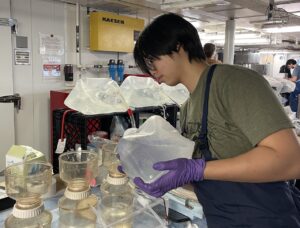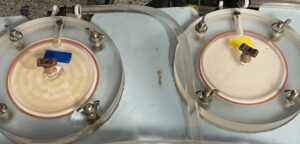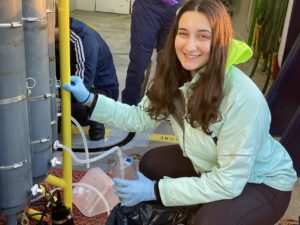Thursday, June 08, 2023 – Offshore North Pacific Coast (Latitude: 39.13.232 N, Longitude: 124.13.608 W)
A Diatom Production

We have been following upwelling currents between Oregon and California and collecting seawater samples with billions of microbes. The primary microbe of interest is the Diatom, which is a single-celled organism classified as a protist. The autotrophs, heterotrophs, and mixotrophs discussed earlier are also classified as protists. (See Day 11). These microbes are extremely small but they play a vital role in our planet’s health and stability.

Prisca Lim and Emily Speciale (both from the Marchetti Lab at UNC-CH) are investigating the physiological responses of diatoms during the upwelling cycle. They are measuring diatom productivity by filtering seawater samples and capturing the diatom cells for analysis. Prisca has two filtration systems set up in the shipboard lab. One system filters the diatoms for DNA analysis and the other system filters the diatoms from RNA analysis. According to Prisca, “DNA analysis will tell us which diatoms are here [in the upwelling plume] and the RNA analysis will tell us what the diatoms are doing” through gene expression.

Emily Speciale is investigating the primary productivity levels of phytoplankton “which is basically the rate at which [the phytoplankton] photosynthesize.” After collecting her seawater from the upwelling site, Emily adds carbon and nitrogen to her samples before filtering them through a stacked filtering system that will separate the larger diatoms (>5um) from the smaller plankton (<5um). The phytoplankton trapped on the filters is frozen and stored onboard until she returns to the lab at UNC-CH. The lab results will indicate the concentration levels of carbon and nitrogen in the phytoplankton. “Higher levels of carbon and nitrogen indicate a more productive community.”
